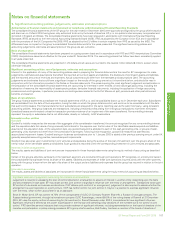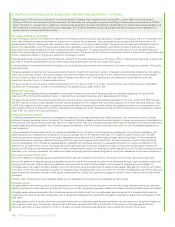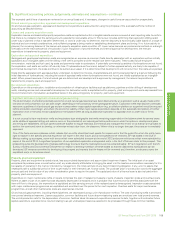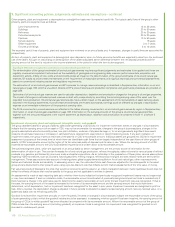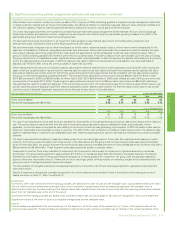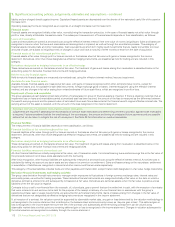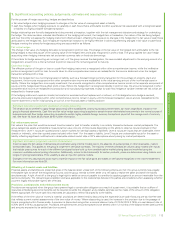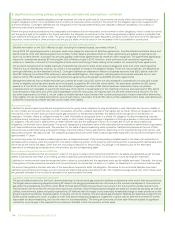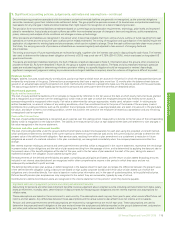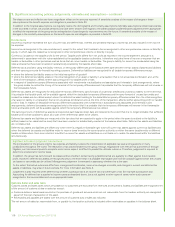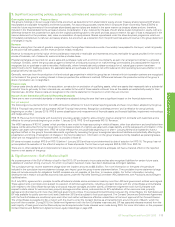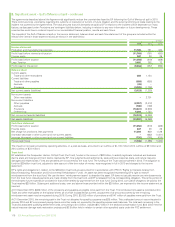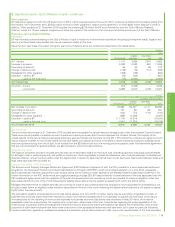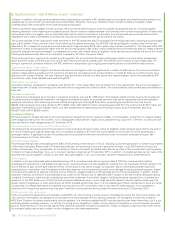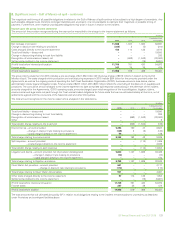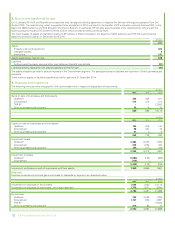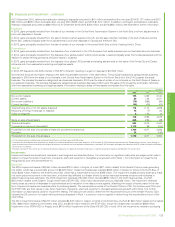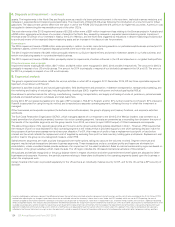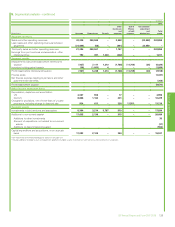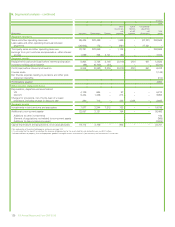BP 2015 Annual Report Download - page 120
Download and view the complete annual report
Please find page 120 of the 2015 BP annual report below. You can navigate through the pages in the report by either clicking on the pages listed below, or by using the keyword search tool below to find specific information within the annual report.
1. Significant accounting policies, judgements, estimates and assumptions – continued
The discount rate and inflation rate have a significant effect on the amounts reported. A sensitivity analysis of the impact of changes in these
assumptions on the benefit expense and obligation is provided in Note 23.
In addition to the financial assumptions, we regularly review the demographic and mortality assumptions. Mortality assumptions reflect best practice
in the countries in which we provide pensions and have been chosen with regard to the latest available published tables adjusted where appropriate
to reflect the experience of the group and an extrapolation of past longevity improvements into the future. A sensitivity analysis of the impact of
changes in the mortality assumptions on the benefit expense and obligation is provided in Note 23.
Income taxes
Income tax expense represents the sum of current tax and deferred tax. Interest and penalties relating to income tax are also included in the income
tax expense.
Income tax is recognized in the income statement, except to the extent that it relates to items recognized in other comprehensive income or directly in
equity, in which case the related tax is recognized in other comprehensive income or directly in equity.
Current tax is based on the taxable profit for the period. Taxable profit differs from net profit as reported in the income statement because it is
determined in accordance with the rules established by the applicable taxation authorities. It therefore excludes items of income or expense that are
taxable or deductible in other periods as well as items that are never taxable or deductible. The group’s liability for current tax is calculated using tax
rates and laws that have been enacted or substantively enacted by the balance sheet date.
Deferred tax is provided, using the liability method, on temporary differences at the balance sheet date between the tax bases of assets and liabilities
and their carrying amounts for financial reporting purposes. Deferred tax liabilities are recognized for all taxable temporary differences except:
• where the deferred tax liability arises on the initial recognition of goodwill
• where the deferred tax liability arises on the initial recognition of an asset or liability in a transaction that is not a business combination and, at the
time of the transaction, affects neither accounting profit nor taxable profit or loss
• in respect of taxable temporary differences associated with investments in subsidiaries and associates and interests in joint arrangements, where
the group is able to control the timing of the reversal of the temporary differences and it is probable that the temporary differences will not reverse in
the foreseeable future.
Deferred tax assets are recognized for deductible temporary differences, carry-forward of unused tax credits and unused tax losses, to the extent that
it is probable that taxable profit will be available against which the deductible temporary differences and the carry-forward of unused tax credits and
unused tax losses can be utilized except where the deferred tax asset relating to the deductible temporary difference arises from the initial recognition
of an asset or liability in a transaction that is not a business combination and, at the time of the transaction, affects neither accounting profit nor taxable
profit or loss. In respect of deductible temporary differences associated with investments in subsidiaries and associates and interests in joint
arrangements, deferred tax assets are recognized only to the extent that it is probable that the temporary differences will reverse in the foreseeable
future and taxable profit will be available against which the temporary differences can be utilized.
The carrying amount of deferred tax assets is reviewed at each balance sheet date and reduced to the extent that it is no longer probable that sufficient
taxable profit will be available to allow all or part of the deferred tax asset to be utilized.
Deferred tax assets and liabilities are measured at the tax rates that are expected to apply in the period when the asset is realized or the liability is
settled, based on tax rates (and tax laws) that have been enacted or substantively enacted at the balance sheet date. Deferred tax assets and liabilities
are not discounted.
Deferred tax assets and liabilities are offset only when there is a legally enforceable right to set off current tax assets against current tax liabilities and
when the deferred tax assets and liabilities relate to income taxes levied by the same taxation authority on either the same taxable entity or different
taxable entities where there is an intention to settle the current tax assets and liabilities on a net basis or to realize the assets and settle the liabilities
simultaneously.
Significant estimate or judgement: income taxes
The computation of the group’s income tax expense and liability involves the interpretation of applicable tax laws and regulations in many
jurisdictions throughout the world. The resolution of tax positions taken by the group, through negotiations with relevant tax authorities or through
litigation, can take several years to complete and in some cases it is difficult to predict the ultimate outcome. Therefore, judgement is required to
determine provisions for income taxes.
In addition, the group has carry-forward tax losses and tax credits in certain taxing jurisdictions that are available to offset against future taxable
profit. However, deferred tax assets are recognized only to the extent that it is probable that taxable profit will be available against which the unused
tax losses or tax credits can be utilized. Management judgement is exercised in assessing whether this is the case.
To the extent that actual outcomes differ from management’s estimates, income tax charges or credits, and changes in current and deferred tax
assets or liabilities, may arise in future periods. For more information see Note 8.
Judgement is also required when determining whether a particular tax is an income tax or another type of tax (for example a production tax).
Accounting for deferred tax is applied to income taxes as described above, but is not applied to other types of taxes; rather such taxes are
recognized in the income statement on an appropriate basis.
Customs duties and sales taxes
Customs duties and sales taxes which are passed on to customers are excluded from revenues and expenses. Assets and liabilities are recognized net
of the amount of customs duties or sales tax except:
• Customs duties or sales taxes incurred on the purchase of goods and services which are not recoverable from the taxation authority are recognized
as part of the cost of acquisition of the asset.
• Receivables and payables are stated with the amount of customs duty or sales tax included.
The net amount of sales tax recoverable from, or payable to, the taxation authority is included within receivables or payables in the balance sheet.
116 BP Annual Report and Form 20-F 2015



